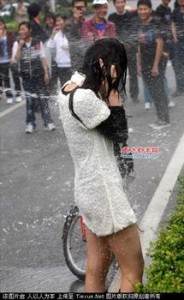Who knew? Shenzhen does have some history
Posted: 09/25/2013 11:00 amAs an op-ed in Shenzhen Daily pointed out in 2011, Shenzhen is not just a 30 year-old cultural wasteland. The city has relics that show the first county was established here more than 1,700 years ago, and the first human activity here is known to have taken place 6,700 years ago, during the Neolithic Age.
An article in Shenzhen Economic Daily which listed five ancient buildings in the city has been doing the rounds on Sina Weibo. Here they are:
Crane Lake New Dwelling
Hehu Xinju, also known as Crane Lake New Dwelling, is the largest example of Hakka vernacular architecture in the country. According to the book Hakka Enclosed Houses, it was built in 1817 and is the ancestral house of the Luos which occupies an area of 2.5 hectares in Longgang.
The Temple Guy blog describes it as being made of three central structures and two horizontal houses that are separated by walls. Inside the walls are found houses, halls, rooms and wells which are scattered evenly apart and are well preserved.
In 1996, the local government converted it into a museum dedicated to Hakka culture, which means visitors are free to enter most of the estimated 300 rooms.
Dawan Building
Dawan Dwelling, which is located in Pingshan Town and was built in 1791, occupies an area of 15,000 square metres and was the home of Hakka settlers.
It was named a city-level protected heritage site in 1984 and a provincial level protected site in 2002.
Visitors to the dwelling get a good idea as to how the Hakka people lived in previous centuries.
Longtian Dwelling
Located at Tianduanxing village in Kengzi Town and built in 1837, Longtian Dwelling is the best preserved Hakka dragon house in the city.
There is a 16-metre wide pool outside, resembling a city moat. Such dwellings were built to be difficult to attack, which may be because in ancient China many exiles were sent to the south. For this reason, it appears imposing from the outside while inside it is very compact.
Dapeng Ancient City
Built in 1394, Dapeng Ancient City was built as a fortress from which Japanese pirates would be combated during the Ming Dynasty.
In the early Qing Dynasty it became a naval base, playing an important role in the Opium Wars.
In 2004, it was named among the 8 most important scenic spots in Shenzhen, along with Dameisha, Xiaomeisha, and Lianhua Mountain.
Although people live in the city, much of it is extremely well preserved.
Xin’an Ancient City
Despite having largely been demolished and replaced with modern urban buildings, Nanshan District’s Xin’an Ancient City (also known as Nantou Ancient City) still boasts a number of historic buildings such as naval and civic headquarters, an opium den and even a brothel.
The area, which boasts 1730 years of history, is still the political, trade and cultural hub of Nanshan.
According to research, what is now the southern part of the city was completed around 1394 under the rule of the Hongwu Emperor during the Ming Dynasty.
It was established as a county in 1573 under the Wanli Emperor and the city became known as Dongguan Castle. At that time, around 1,000 soldiers would be stationed there, commanded to protect the areas now known as Shenzhen, Dongguan and Hong Kong, according to James Baquet of Shenzhen Daily.
The castle’s gate still stands next to Zhongshan Park.


















